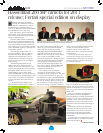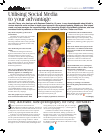
16
23
rd
SEPTEMBER 2010 Day Three
world of imaging
2010
The 14 tents of Oktoberfest:
Every year there are 14 main tents set
up for the Oktoberfest, each sponsored by a
different Munich brewery. The tents vary in
size and each serve their specially brewed
beer!
Some of the famous tents:
Schottenhamel Festhalle: This is the
oldest tent at Oktoberfest, dating back to 1867.
It is also considered the most important by
some as it is where Munich’s Mayor kicks off
the festival by tapping the rst keg of beer.
Schotenhammel is the largest Oktoberfest tent
with 10,000 seats.
Hackerbräu-Festzelt: Amongst the largest
Oktoberfest tents at Oktoberfest, its ceiling
is painted with blue skies and white clouds
and locals call this tent “Himmel der Bayern”
(Heaven for Bavarians).
Weinzelt: This tent is where you can enjoy
an extensive wine and champagne selection.
Besides traditional Oktoberfest dishes, the
wine tent also has seafood and even Thai
delicacies on its menu.
W
hen you think alcohol festivals, there’s
just one name that immediately comes
to mind – Oktoberfest! Think Bavarian
barmaids in elaborate dirndls, loud polka
tunes, sausages, sauerkraut (sweet and sour
cabbage), and apple strudel. Think tons of beer
suds, and then think of some more. Think ‘Bier
Paradise’! This is just some of what you’ll nd
at the Munich Oktoberfest.
And what could be a better follow up to
Photokina than Oktoberfest. So head down to
Munich, just 3 hours away from Cologne by
train, for the world-famous Oktoberfest (18
September –3 October). If just the thought
of beer isn’t enough to entice you, read on to
learn how the festival began and know what
you’ll be losing out on if you decide to skip it.
You may have missed the beginning but you’ll
still have plenty of time to make up for it.
Journeying back:
On 12 October, 1810, Bavaria’s Crown
Prince Ludwig married Princess Therese von
Sachsen-Hildburghausen. To celebrate their
union, the royal family and the citizens of
Munich gathered on the elds in front of the
city gates to be part of the festivities were
held over ve days and ended with a horse
race. The celebration was so popular that the
following year, the celebrations continued and
an agricultural show was also included. And
thus began the legendary Oktoberfest.
Over the years, additions were made like
amusement areas with wheel barrow and sack
races, mush eating contests, mechanical rides
and in 1908, the festival boasted Germany’s
rst roller coaster. When beer initially came
into the mix, makeshift beer stands began
cropping up, and in 1896 they were eventually
replaced by enormous beer tents of today,
each of which is sponsored by a local Munich
brewery. The festival was also prolonged and
moved ahead to September because of the
better weather conditions. Today the festival
spans 16 days and the last day of the festival
is the rst Sunday in October. The Oktoberfest
has been hosted in the same 420,000 square-
meter open eld since 1890 which was named
‘Theresienwiese’ or ‘Theresa’s meadow’ and
today the festival is undoubtedly the largest
festival in the world with over 6 million
visitors every year.
Time-
honoured
Traditions:
Grand
entry of
landlords and
breweries:
The
traditional
prelude to
the start of
Oktoberfest
is the entry of
the landlords
and breweries.
A procession
of oats and ower-decked carriages drawn by
noble steeds carrying large beer barrels on their
way to the Theresienwiese.
Oktoberfest 2010:
Beer Serving Hours:
Weekdays: 10am - 10:30pm
Saturdays, Sundays and holidays: 9am -
10:30pm
Daily Tent Closing Time: 11:30pm
The Käfer Wiesn-Schänke and the Weinzelt
tents are open until 1am. Last call for
alcohol: 12:15am
Ein Prosit
Raise a toast at
the Oktoberfest!
Opening
Ceremony
of the
Oktoberfest:
At noon,
the mayor of
Munich taps
the rst keg
of Oktoberfest
beer with the
traditional
cry “O`zapft
is!” (“It is
tapped!”), followed by a 12 gun salute. After
that, all Oktoberfest beer halls are allowed to
tap their beer kegs, and Oktoberfest moves into
high gear with all the visitors being allowed to
quench their thirst.
Oktoberfest Costume and Riemen’s Parade:
The world-famous parade is one of the
best and most colourful displays of Bavarian
history, culture, and tradition. Approximately
9,000 participants will present a variety of
regional costumes, and folk dances. The
3-mile long procession also has “troops”
in historical uniforms, marching bands,
riemen, thoroughbred horses, and even
oxen, cows, and goats.
Open-Air Oktoberfest Concert:
On the second Sunday of the festival the
steps of the Bavaria statue are lled with
more than 400 Bavarian musicians who
gather for an open-air concert. This year the
concert will be on Sunday, 26 September
2010 at 11 am.
So book your tickets and don’t forget to
wish everyone Gemutlichkeit (Good spirits to
you!) to the tune of clinking of beer mugs!
Karina Aggarwal


















